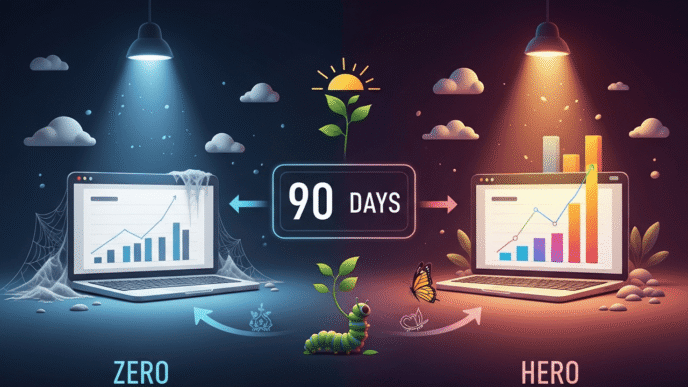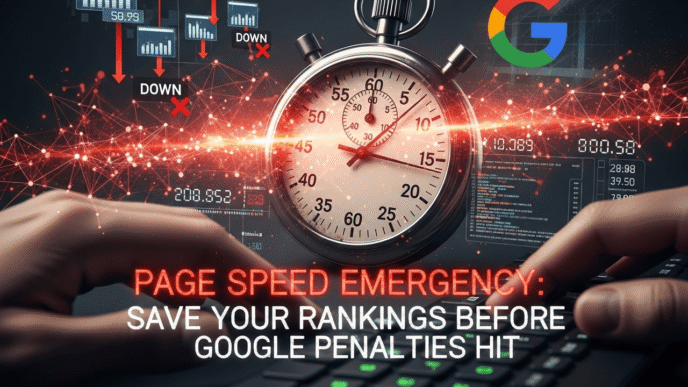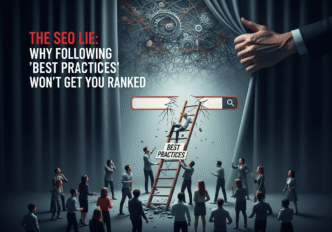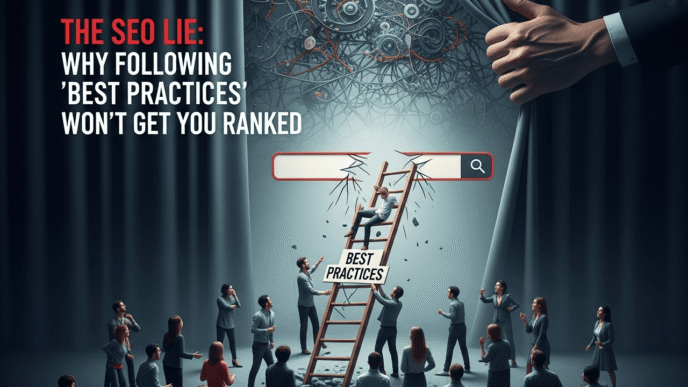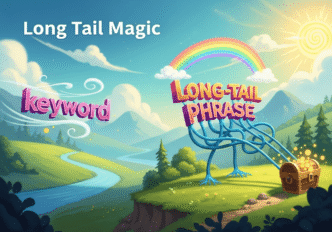Picture this: You wake up on a Tuesday morning, grab your coffee, and check your website traffic. Suddenly, your heart drops. Your organic traffic has plummeted by 40% overnight. Sound familiar?
If you’ve been in the SEO game for more than five minutes, you’ve probably experienced this nightmare. The culprit? A Google algorithm update that blindsided you while you were sleeping.
Google algorithm updates tracking isn’t just a fancy SEO term – it’s your lifeline in the ever-changing world of search engine optimization. Without proper tracking, you’re essentially driving blindfolded on a highway where the rules change every few weeks.
Table of Contents
Toggle
What Are Google Algorithm Updates and Why Should You Care?
Google tweaks its search algorithm thousands of times each year. Most are minor adjustments that barely register on your analytics dashboard. But the major updates? They can make or break your online visibility faster than you can say “PageRank.”
Think of Google’s algorithm as a constantly evolving recipe. Sometimes they add a pinch of salt (minor update), and sometimes they completely change the main ingredient (major core update). Your job is to taste-test every change before it affects your rankings.
The search giant processes over 8.5 billion searches daily. With that volume, even small algorithm changes can have massive ripple effects across millions of websites.
How Do Google Algorithm Updates Actually Impact Your Website Rankings?
Algorithm updates work like digital earthquakes – some are minor tremors you barely notice, while others can completely reshape your search landscape.
Core updates typically affect how Google evaluates content quality, relevance, and user experience. If your site doesn’t align with Google’s evolving standards, you might find yourself buried on page three (the digital equivalent of Siberia).
Spam updates target manipulative SEO tactics like keyword stuffing, link schemes, and thin content. These updates can result in manual penalties that are harder to recover from than natural ranking drops.
Here’s what typically gets hit during major updates:
- Sites with poor user experience metrics
- Content that lacks expertise, authority, and trustworthiness (E-A-T)
- Pages with slow loading speeds or mobile usability issues
- Websites using outdated SEO tactics
Which Tools Can Help You Track Google Algorithm Updates?
Effective Google algorithm updates tracking requires the right arsenal of tools. Here’s a comparison of the most reliable options:
| Tool | Free/Paid | Best Feature | Update Speed | Difficulty Level |
|---|---|---|---|---|
| Google Search Console | Free | Direct from Google | 1-3 days | Beginner |
| SEMrush Sensor | Paid | Volatility tracking | Real-time | Intermediate |
| Moz MozCast | Free | Weather-style updates | Daily | Beginner |
| Ahrefs Rank Tracker | Paid | Comprehensive monitoring | Real-time | Advanced |
| Algoroo | Free | Simple volatility meter | Daily | Beginner |
| Advanced Web Ranking | Paid | Detailed SERP analysis | Real-time | Advanced |
Pro Tip: Don’t rely on just one tool. Combine free options like Google Search Console with paid tools for comprehensive coverage. Think of it as having both a weather app and looking outside your window – you get the full picture.
Free Tools That Actually Work
Google Search Console remains your best friend for tracking algorithm impacts. It shows you exactly which pages lost visibility and provides hints about why.
MozCast presents algorithm volatility as a weather forecast – temperatures above 70°F indicate stormy SERP weather (high volatility), while cooler temperatures suggest calm seas.
Algoroo offers a simple volatility meter that’s perfect for quick daily checks without overwhelming data.
Premium Tools Worth the Investment
SEMrush Sensor tracks volatility across 20+ categories and provides mobile vs. desktop breakdowns. It’s like having a seismograph for search results.
Ahrefs Rank Tracker combines algorithm monitoring with detailed keyword tracking, helping you connect ranking changes to specific updates.
What Should You Monitor When Tracking Algorithm Changes?
Successful Google algorithm updates tracking goes beyond just watching your rankings bounce around like a ping-pong ball.
Core Metrics to Track Daily
Organic traffic patterns tell the real story. Set up automated alerts for traffic drops exceeding 15% day-over-day.
SERP volatility indicators help you distinguish between algorithm updates and seasonal fluctuations. High volatility across multiple tools usually signals an update.
Click-through rates (CTR) can drop even if your rankings stay stable, indicating changes in how Google displays search results.
Advanced Tracking Techniques
Keyword position tracking should focus on your money keywords – those that drive the most valuable traffic and conversions.
Monitor featured snippet performance since algorithm updates often affect snippet selection criteria.
Track local search visibility separately, as local algorithm updates can affect local businesses differently than organic results.
Pro Tip: Create custom dashboard alerts that trigger when multiple metrics show negative changes simultaneously. This helps you differentiate between normal fluctuations and algorithm impacts.
How Can You Prepare Your Website Before Algorithm Updates Hit?
The best defense against algorithm updates is building a website that aligns with Google’s long-term vision rather than chasing short-term ranking tricks.
Building Algorithm-Proof Content
Focus on user intent optimization rather than keyword density. Google’s getting scary good at understanding what users actually want.
Create comprehensive topic coverage that answers related questions users might have. This approach naturally incorporates long-tail keywords and LSI terms.
Invest in original research and data that other sites will want to link to. High-quality backlinks remain one of the strongest ranking signals.
Technical SEO Foundations
Core Web Vitals optimization isn’t optional anymore. Pages that load slowly or shift unexpectedly during loading face ranking penalties.
Ensure mobile-first design since Google predominantly uses mobile crawling for indexing and ranking.
Implement structured data markup to help Google understand your content context and purpose.
What Steps Should You Take When an Algorithm Update Hits Your Site?
Don’t panic. Seriously. Algorithm update recovery is like treating a patient – rushing into surgery without proper diagnosis usually makes things worse.
Immediate Response (First 48 Hours)
Document the damage by taking screenshots of your analytics and search console data. This creates a baseline for measuring recovery.
Avoid making hasty changes to your website. Many ranking drops are temporary and resolve within a few days as Google’s systems stabilize.
Gather intelligence from multiple tracking tools to confirm whether you’re experiencing an algorithm impact or another issue.
Analysis Phase (Week 1-2)
Identify affected pages using Google Search Console’s performance reports. Look for pages that lost the most clicks and impressions.
Analyze competitor performance to understand whether the impact is site-specific or industry-wide.
Review recent content changes you made before the update to identify potential causes.
Recovery Strategy (Ongoing)
Focus on content quality improvements rather than technical quick fixes. Most modern algorithm updates target content relevance and user satisfaction.
Enhance user experience signals like reducing bounce rates and increasing time on page through better content organization.
Build topical authority by creating comprehensive content clusters around your main topics.
Pro Tip: Keep a detailed log of all changes you make during recovery. This documentation becomes invaluable for future algorithm updates and helps you identify what actually works.
Real-World Case Study: How One E-commerce Site Survived a Major Core Update
Let me share a real example of effective Google algorithm updates tracking in action.
TechGadgets.com (name changed for privacy) experienced a 35% traffic drop during the August 2023 core update. Instead of panicking, they followed a systematic recovery approach.
What they did wrong initially:
- Thin product descriptions copied from manufacturers
- Minimal original content beyond basic specifications
- Poor internal linking structure
- Slow page loading speeds on mobile
Their tracking and recovery process:
- Week 1: Used Google Search Console and SEMrush to identify affected product categories
- Week 2-4: Analyzed top-performing competitors to understand content gaps
- Month 2-3: Rewrote product descriptions with original buying guides and comparison tables
- Month 4: Improved site speed and mobile experience
- Month 5-6: Built topical authority with comprehensive buying guides
Results after 6 months:
- Traffic recovered to 110% of pre-update levels
- Average session duration increased by 40%
- Conversion rates improved by 25%
The key lesson? They treated the algorithm update as an opportunity to fix underlying content quality issues rather than a technical problem to hack around.
Advanced Algorithm Update Tracking Strategies for 2025
The SEO landscape continues evolving, and your Google algorithm updates tracking strategy should evolve with it.
AI and Machine Learning Integration
Predictive analytics tools now help identify potential algorithm vulnerabilities before updates hit. Tools like MarketMuse and Clearscope use AI to analyze content quality gaps.
Automated monitoring systems can track hundreds of ranking factors simultaneously, alerting you to patterns humans might miss.
Multi-Channel Impact Analysis
Modern algorithm updates affect more than just organic search. Track impacts on:
- Google Business Profile visibility
- Google Shopping performance
- YouTube search rankings (often overlooked but crucial for many businesses)
- Google Images optimization results
Pro Tip: Create correlation maps between different Google properties. Changes in YouTube algorithm often precede similar changes in web search, giving you advance warning of potential impacts.
Common Algorithm Update Tracking Mistakes That Kill Recovery Efforts
Even experienced SEO professionals make critical errors when tracking and responding to algorithm updates.
Over-Optimization Panic
Mistake: Making dramatic changes immediately after a ranking drop. Reality: Most algorithm impacts need 2-4 weeks to fully settle before you can assess true damage.
Solution: Implement a “cooling off” period before making major site changes.
Ignoring Positive Changes
Mistake: Only focusing on pages that lost rankings while ignoring pages that gained visibility. Reality: Understanding what Google rewarded helps you replicate success across your site.
Solution: Analyze both winners and losers to identify ranking factor patterns.
Tool Tunnel Vision
Mistake: Relying on a single monitoring tool or metric. Reality: Each tool has blind spots and biases that can mislead your analysis.
Solution: Cross-reference data from multiple sources before drawing conclusions.
Building Your Algorithm Update Response Team
Google algorithm updates tracking shouldn’t fall on one person’s shoulders. Here’s how to structure your response team:
Essential Team Roles
SEO Analyst: Monitors tools, identifies patterns, and creates initial impact reports Content Strategist: Analyzes content performance and develops improvement plans
Technical SEO Specialist: Handles site speed, mobile optimization, and structural issues Project Manager: Coordinates response efforts and maintains timeline accountability
Communication Protocols
Establish clear escalation procedures for different severity levels:
- Green Alert (0-10% traffic drop): Weekly monitoring reports
- Yellow Alert (10-25% drop): Daily check-ins and analysis updates
- Red Alert (25%+ drop): Emergency response protocols with daily team meetings
Future-Proofing Your SEO Strategy Against Algorithm Changes
The most successful websites don’t just survive algorithm updates – they thrive because they’re already aligned with Google’s evolving priorities.
Core Principles That Never Go Out of Style
User-first content creation remains the foundation of algorithm-proof SEO. Ask yourself: “Would I find this content valuable if I weren’t the one who created it?”
Technical excellence in site performance, mobile usability, and crawl efficiency creates a strong foundation that withstands most updates.
Authentic expertise demonstration through comprehensive, accurate, and helpful content naturally incorporates the signals Google looks for.
Emerging Trends to Watch
AI content evaluation is becoming more sophisticated. Google’s algorithms can increasingly detect AI-generated content that lacks human insight and experience.
User behavior signals like dwell time, click-through rates, and return visits carry more weight in ranking decisions.
Topical authority trumps domain authority in many competitive niches. Deep expertise in specific topics outperforms broad, shallow coverage.
Pro Tip: Build content partnerships with recognized experts in your field. Their involvement adds authentic expertise signals that algorithms increasingly recognize and reward.
Common Algorithm Update Tracking Mistakes That Could Destroy Your Recovery
Even experienced SEO professionals fall into these critical traps when tracking and responding to algorithm updates. Avoid these costly errors:
The “Panic Button” Syndrome
Mistake: Making dramatic site changes within 24-48 hours of a ranking drop. Reality: Most websites are unaffected by core updates, but those experiencing significant traffic drops should assess their content and wait for the update to fully roll out. Cost: Can worsen your ranking position if you’re chasing the wrong signals.
Single-Tool Tunnel Vision
Mistake: Relying solely on one tracking tool or Google Search Console data. Why it fails: Each tool has unique algorithms and data sources. SEMrush might show volatility while Ahrefs shows stability. Solution: Cross-reference at least 3 different data sources before drawing conclusions.
The “Quick Fix” Trap
Mistake: Implementing technical “hacks” immediately after ranking drops. Truth: Making meaningful content improvements and avoiding quick fixes are recommended for addressing ranking drops. Better approach: Focus on fundamental content quality improvements over technical band-aids.
Ignoring Positive Signals
Mistake: Only analyzing pages that lost rankings while overlooking winners. Missed opportunity: Understanding what Google rewarded helps you replicate success across your entire site. Action: Create a “winners and losers” analysis for every major update.
Timeline Confusion
Mistake: Comparing traffic data during the update rollout period. Problem: Rankings fluctuate wildly during rollouts, making analysis unreliable. Correct approach: Wait at least a full week after a core update completes before analyzing your site in Search Console.
Essential External Resources for Algorithm Update Tracking
Stay informed with these authoritative sources that provide real-time algorithm intelligence:
Official Google Resources
- Google Search Status Dashboard: Real-time updates on confirmed algorithm changes and system issues
- Google Search Central: Official algorithm update announcements and guidance
Industry Intelligence Platforms
- Search Engine Roundtable: Most comprehensive tracking of confirmed and unconfirmed Google updates with expert analysis
These resources provide the authoritative foundation for your tracking strategy, eliminating guesswork and ensuring you’re responding to real algorithm changes rather than normal ranking fluctuations.
Algorithm Update Impact: Latest 2025 Statistics and Data
Understanding the current algorithm landscape requires examining recent data and trends shaping the SEO industry in 2025.
2024-2025 Algorithm Update Frequency and Impact
Google launched seven official and confirmed algorithmic updates in 2024, four core updates and three spam updates. The March 2024 core update was massive, updating several systems within the core algorithm.
Key 2025 Statistics:
- Multiple data providers reported that the March 2025 core update had similar volatility to the December 2024 update
- The March 2024 core update started rolling out March 5, took 45 days to complete, and finished on April 19 – making it the longest core update rollout in history
- During the rollout period, SERP inconsistencies were identified across third-party tracking tools which suggested significant drops in rankings for some
AI Integration Impact on Algorithm Updates
The integration of AI into Google’s search algorithms represents the most significant shift in SEO tracking requirements:
AI Overviews Growth:
- AI Overviews were triggered for 6.49% of queries in January… That climbed to 7.64% in February (an 18% increase)… And then up to 13.14% by March (72% growth from the previous month)
- 88.1% of queries that trigger an AI Overview are informational
Search Console AI Tracking:
- AI Mode clicks, impressions, and positions are now in Search Console as of June 2025
- AI Mode data has arrived in Google Search Console as of around June 13th onwards
Industry Adoption of AI for SEO Tracking
The SEO industry is rapidly adopting AI tools for algorithm update tracking and response:
- 61% of marketers see AI as the key part of their strategy
- 75% of marketers leverage AI to reduce the time spent on manual tasks like keyword research and meta-tag optimization
- As of 2025, 56% of marketers are already using generative AI for SEO
- AI-driven SEO can boost organic traffic by 45% and conversion rates by 38% for e-commerce websites
Trending AI/SEO Topics Transforming Algorithm Update Tracking in 2025
The convergence of AI and SEO is reshaping how we track and respond to algorithm updates. Here are the critical trends every SEO professional must understand:
1. AI-Powered Predictive Algorithm Analysis
What’s happening: 47% of marketers are already implementing AI SEO tools to improve search efficiency, and another 84% are using them to identify and leverage emerging search trends.
Why it matters: AI tools can now predict potential algorithm vulnerabilities before updates hit, analyzing patterns across millions of data points that humans would miss.
Action required: Integrate AI-powered analysis tools into your monthly audit process to identify content and technical issues before they become algorithm penalties.
2. Search Everywhere Optimization (SEO to SEVRO)
The shift from traditional search engine optimization to “Search Everywhere Optimization” reflects the reality that users now search across multiple AI platforms:
The new reality: Non-Google channels like ChatGPT and Perplexity are capturing more traffic, pushing SEO strategies beyond standard search engines.
Market impact: The AI SEO tools market will grow from $1.2 billion in 2024 to $4.5 billion by 2033, with a CAGR of 15.2%.
Strategy adaptation: Your algorithm tracking must now include performance monitoring across ChatGPT, Claude, Perplexity, and other AI search platforms.
3. The Great Decoupling: Impressions vs. Traffic
The phenomenon: AI Overviews are reducing website clicks by over 30%, even as visibility increases. This shift – often called “The Great Decoupling” – highlights the gap between rising impressions and declining traffic.
Tracking implications: Traditional metrics like click-through rates are becoming less reliable indicators of algorithm performance. Focus on engagement quality and conversion rates from the traffic you do receive.
4. E-E-A-T Evolution for AI-Generated Content
Current challenge: 65.14% of professionals think that the biggest concerns about using generative AI are content quality and authenticity.
Google’s response: Google’s position is clear: AI-generated content faces no inherent penalties – quality and usefulness lead the way.
Algorithm tracking focus: Monitor how your AI-assisted content performs compared to purely human-created content, tracking engagement metrics and ranking stability.
5. Zero-Click Search Impact
The challenge: Keywords that trigger AI Overviews do tend to have higher zero-click rates on average.
Strategic response: Track brand mention frequency and sentiment within AI responses, as traditional traffic metrics become less predictive of business impact.
Your Action Plan: Getting Started With Algorithm Update Tracking Today
Ready to implement bulletproof Google algorithm updates tracking? Here’s your step-by-step starter guide:
Week 1: Foundation Setup
- Connect Google Search Console and verify all property variations
- Set up baseline tracking in at least two monitoring tools (start with free options)
- Create a shared tracking spreadsheet for your team
- Document your current top 20 keywords and their positions
Week 2: Monitoring Infrastructure
- Configure automated alerts for traffic drops exceeding 15%
- Set up competitor tracking for 3-5 main rivals
- Create weekly reporting templates
- Establish team communication protocols
Week 3: Response Preparation
- Audit your current content quality using E-A-T guidelines
- Identify potential technical vulnerabilities
- Create content improvement templates
- Develop recovery timeline frameworks
Week 4: AI Integration Setup
- Test AI-powered SEO analysis tools for predictive insights
- Set up tracking for non-Google AI search platforms
- Configure monitoring for AI Overview appearances
- Establish AI content performance baselines
Ongoing Optimization
- Weekly monitoring and reporting across all platforms
- Monthly AI performance analysis and strategy adjustments
- Quarterly comprehensive site audits including AI content review
- Annual algorithm impact assessments and tool stack evaluation
Final Verdict: The Future of Algorithm Update Tracking
Google algorithm updates tracking has evolved from a reactive damage control process to a proactive, AI-enhanced strategic advantage. The organizations thriving in 2025 aren’t just tracking Google’s algorithm changes – they’re anticipating them.
The bottom line: Since the introduction of Google’s AIO, 63% of marketers have seen improvements in their organic traffic, visibility, or rankings. However, success now requires a fundamentally different approach to tracking and optimization.
Key success factors for 2025 and beyond:
- Multi-platform tracking across traditional and AI search channels
- Predictive analysis using AI-powered tools
- Focus on engagement quality over pure traffic volume
- Authentic expertise demonstration in an AI-saturated content landscape
The websites that consistently rank well aren’t the ones with the cleverest SEO tricks. They’re the ones that understand Google’s mission to provide users with helpful, reliable information and align their content strategy accordingly – while staying ahead of the AI transformation reshaping search.
Remember: 90% of marketers want to use more AI in 2025, and nearly 60% plan to spend more on AI tools. The question isn’t whether AI will impact your SEO strategy – it’s whether you’ll lead or follow this transformation.
The next algorithm update is coming whether you’re ready or not. The question is: will you be caught off guard, or will you be prepared to adapt and thrive in the age of AI-powered search?
Start tracking today, because in the world of SEO, knowledge isn’t just power – it’s survival.
Frequently Asked Questions (FAQ)
How often does Google update its search algorithm?
Google makes thousands of minor changes to its search algorithm each year, but only announces major “core updates” several times annually. Google launched seven official and confirmed algorithmic updates in 2024, four core updates and three spam updates. Most minor changes go unnoticed, while major updates can significantly impact search rankings.
How long should I wait before analyzing the impact of an algorithm update?
Google recommends waiting at least a full week after a core update completes before analyzing your site in Search Console. This allows the algorithm changes to fully settle and provides more accurate data for analysis. Analyzing data during the rollout period can be misleading due to ranking volatility.
Can I recover from an algorithm update penalty, and how long does it take?
Yes, recovery is possible, but it requires a systematic approach. Focus on improving content quality, user experience, and addressing the specific issues that caused the ranking drop. Recovery time varies – some sites see improvements within 2-3 months, while others may take 6-12 months for full recovery. The key is making meaningful, sustainable improvements rather than quick fixes.
Do I need paid tools to track algorithm updates effectively?
While paid tools offer more comprehensive features, you can start with free options. Google Search Console is essential and free, providing direct insights from Google. Combine it with free tools like MozCast and Algoroo for basic tracking. However, 75% of marketers leverage AI to reduce the time spent on manual tasks like keyword research and meta-tag optimization, suggesting paid AI-powered tools provide significant efficiency gains.
How do AI Overviews and AI Mode affect traditional SEO tracking?
AI Overviews were triggered for 6.49% of queries in January… That climbed to 7.64% in February (an 18% increase)… And then up to 13.14% by March (72% growth from the previous month). These features are now tracked in Google Search Console, but they change how we measure success. Focus on brand mentions within AI responses and engagement quality rather than just click-through rates.
Should I be concerned about using AI-generated content after algorithm updates?
Google’s position is clear: AI-generated content faces no inherent penalties – quality and usefulness lead the way. However, 65.14% of professionals think that the biggest concerns about using generative AI are content quality and authenticity. Focus on creating high-quality, helpful content regardless of whether AI assists in the creation process.
What’s the most important metric to track during algorithm updates?
While rankings and traffic are important, focus on holistic performance including user engagement metrics, conversion rates, and brand visibility across multiple search platforms. The trends defining 2025 require a smarter approach to content and intent modeling, meaning quality engagement often matters more than raw traffic volume.
How can I prepare my website to be more resilient to future algorithm updates?
Focus on creating helpful, authoritative content that demonstrates real expertise. Ensure excellent technical SEO foundations including Core Web Vitals optimization and mobile-first design. Build genuine topical authority rather than chasing short-term ranking tactics. 82% of enterprise SEO specialists plan to invest more in AI, suggesting AI integration for content creation and optimization will become essential.
Visual Element Suggestions
1. Algorithm Update Timeline Infographic
Title: “Major Google Algorithm Updates 2024-2025: Impact and Duration” Content: Visual timeline showing the rollout periods, volatility levels, and recovery patterns for major updates including the 45-day March 2024 core update, August 2024 core update, and 2025 updates. Include data bars showing traffic impact percentages and recovery timeframes.
2. AI Search Evolution Flowchart
Title: “The Evolution of Search: From Traditional SEO to AI-Powered Optimization” Content: Multi-path flowchart showing the transformation from traditional keyword-focused SEO to AI-enhanced search optimization. Include decision points for AI Overview optimization, multi-platform tracking, and new success metrics. Highlight the shift from single-platform (Google) to multi-platform (Google, ChatGPT, Perplexity, etc.) tracking requirements.
3. Algorithm Update Response Decision Tree
Title: “Algorithm Update Response Framework: When to Act vs. When to Wait” Content: Interactive decision tree starting with “Traffic Drop Detected” and branching into various scenarios: update confirmed/unconfirmed, traffic drop percentage ranges (0-10%, 10-25%, 25%+), time since update completion, and corresponding recommended actions. Include specific timeframes and threshold triggers for different response levels.
Interactive SEO & Algorithm Update Dashboard
Explore Google's algorithm changes and the evolution of search optimization
Major Google Algorithm Updates 2024-2025
Click on any update to see detailed impact analysis
March 2024 Core Update
Major ImpactLongest rollout in history. Updated multiple core systems and integrated helpful content system.
Most Affected Areas:
August 2024 Core Update
High ImpactFocused on helping small publishers affected by previous updates.
Most Affected Areas:
November 2024 Core Update
Medium ImpactStandard core update focusing on search result quality improvements.
Most Affected Areas:
December 2024 Core Update
Medium ImpactSurprise update focusing on different core systems.
Most Affected Areas:
March 2025 Core Update
Medium ImpactSimilar volatility to December 2024 update with industry-specific impacts.
Most Affected Areas:
2024 Algorithm Update Summary
The Evolution of Search Optimization
From Traditional SEO to AI-Powered Multi-Platform Strategy
Traditional SEO
2000-2022
Keyword-focused optimization
Key Features
- Keyword density
- Meta tags
- Backlinks
- Technical SEO
Platforms
Success Metric
Rankings & TrafficAI Integration Phase
2023-2024
AI tools enter SEO workflows
Key Features
- AI content creation
- Automated optimization
- Predictive analysis
- BERT & RankBrain
Platforms
Success Metric
Efficiency + QualityAI Overviews Era
2024-2025
AI answers dominate search
Key Features
- AI Overviews (13.14% queries)
- Zero-click searches
- AI Mode tracking
- SGE rollout
Platforms
Success Metric
Visibility + AuthoritySearch Everywhere (SEVRO)
2025+
Multi-platform optimization
Key Features
- Cross-platform tracking
- AI brand mentions
- Conversational search
- Predictive SEO
Platforms
Success Metric
Omnichannel PresenceAI SEO Statistics 2025
Data sources: Google Search Central, Semrush, Search Engine Land, Industry Reports





